The Motorola Moto Z & Moto Z Force (Droid Editions) Review
by Matt Humrick on July 28, 2016 8:00 AM ESTThe Qualcomm Snapdragon 820 SoC inside the Moto Z Droids has proven to be a popular choice for flagship phones this year. Its four custom 64-bit Kryo CPU cores and Adreno 530 GPU are at the heart of nearly every high-end phone currently available. We’ve already tested the performance and battery life of several of these phones, so we already have a good idea of what to expect from the Moto Zs. In this review then, we’ll limit our focus to only a few tests from our usual suite to see how Motorola’s implementation stacks up against its competitors.
System Performance
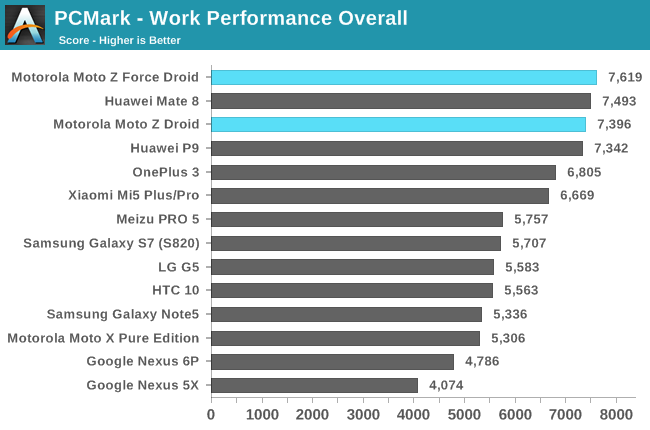
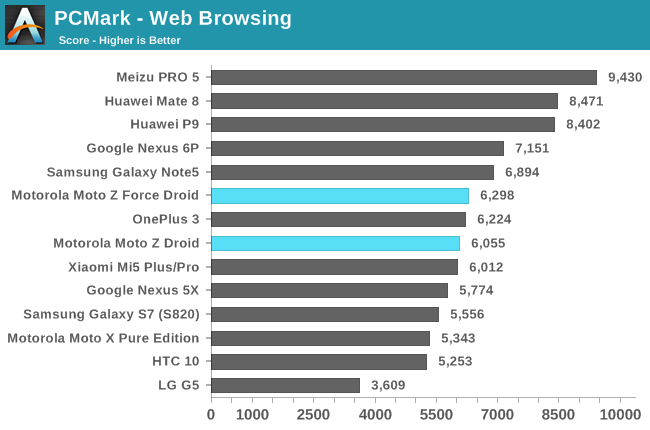

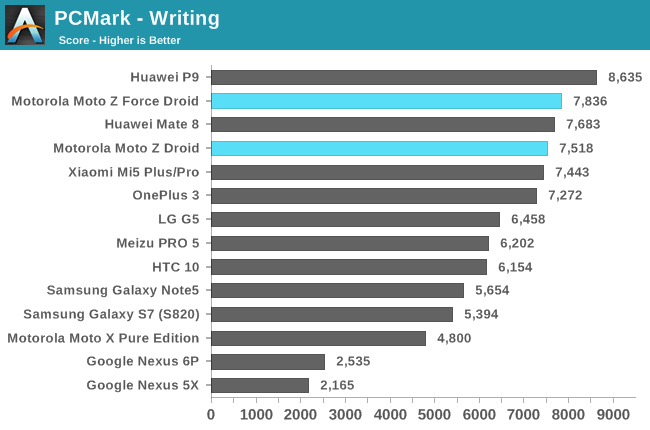
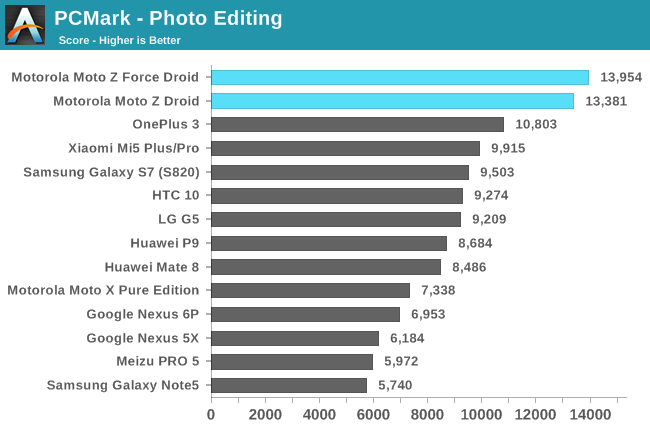
Because PCMark relies heavily on Android API calls to run real-world workloads that exercise the CPU, GPU, RAM, and NAND storage, it’s a good indicator of general system performance for apps we use everyday. Looking first at the overall score, the Moto Z Droid performs quite well, outperforming the other Snapdragon 820 phones and even the Kirin 950/955 in the Huawei Mate 8 and P9.
Diving a bit deeper reveals that most of the Droids’ advantage comes in the Photo Editing test that performs photo processing on the GPU (if supported). Snapdragon 820 generally does well in this test—it occupies all of the top positions in this chart—but the Droids are at least 24% faster than even the OnePlus 3 and 45% faster than the LG G5, which both use the same SoC. The Droids’ performance boost comes from an updated GPU driver.
The Moto Zs also do well in the Video Playback and Writing tests, again outperforming the other phones running Snapdragon 820, albeit by a much smaller margin. The phones using ARM’s Cortex-A57 and -A72 CPUs perform better than those using Qualcomm’s custom Kryo cores in the Web Browsing test, but the Droids are once again the fastest of the Snapdragon 820 group.
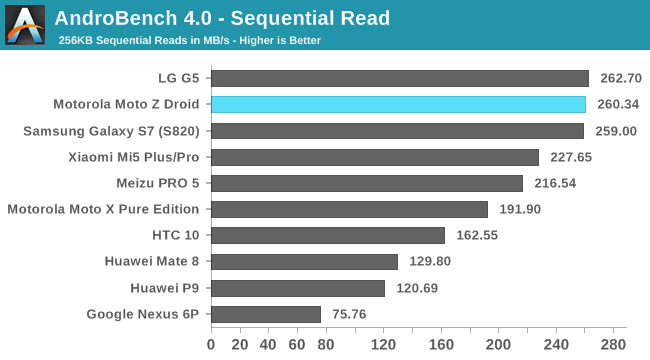
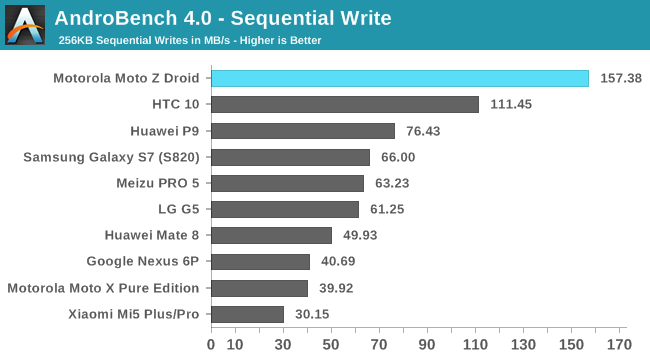
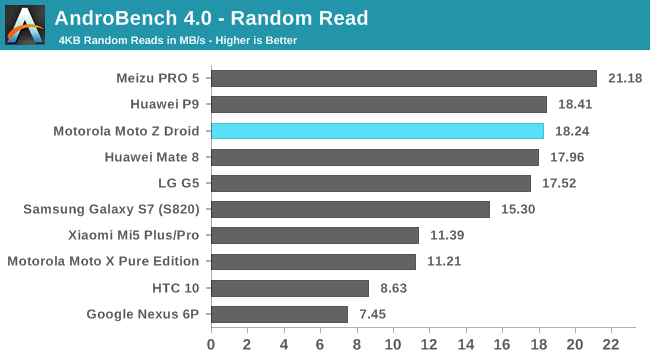
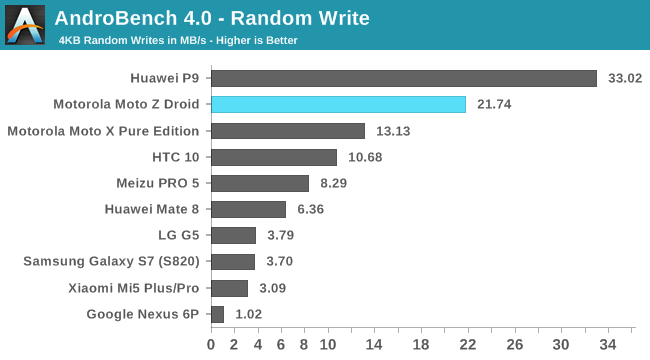
One of the first things I noticed about the new Moto Zs is how quickly they can install and launch apps. Their sequential write performance is excellent, nearly as fast as the iPhone 6s, and sequential read performance is among the best we’ve measured. Random read and write performance is also very good, meeting or exceeding the performance of most flagship phones.
The Moto Z Droid and Moto Z Force Droid we tested are both using 32GB of Samsung KLUBG4G1CE-B0B1 UFS 2.0 NAND. This is the same NAND used by the Galaxy S7 (Snapdragon 820) we tested, so this alone cannot account for the difference in performance. It seems Motorola has done some software tuning to improve internal storage speed.
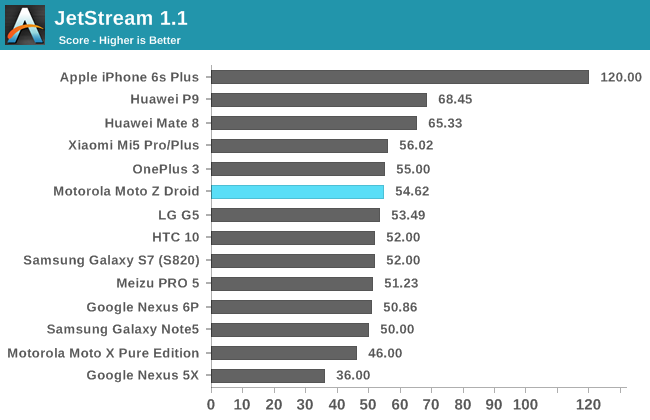
Similar to PCMark’s Web Browsing test, there’s a clear hierarchy in JetStream based on CPU architecture and frequency. The higher-clocked Cortex-A72 cores in Huawei’s P9 and Mate 8 give them a 25% and 20% advantage over the Moto Z Droids, respectively. All of the phones with Qualcomm’s Kryo cores clump together as expected, followed by the phones using the previous generation A57 cores.
GPU Performance
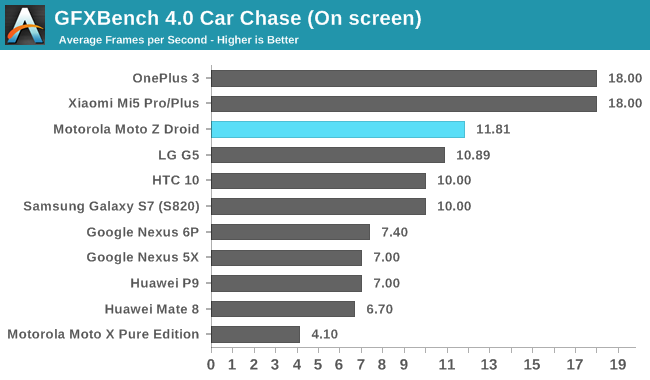
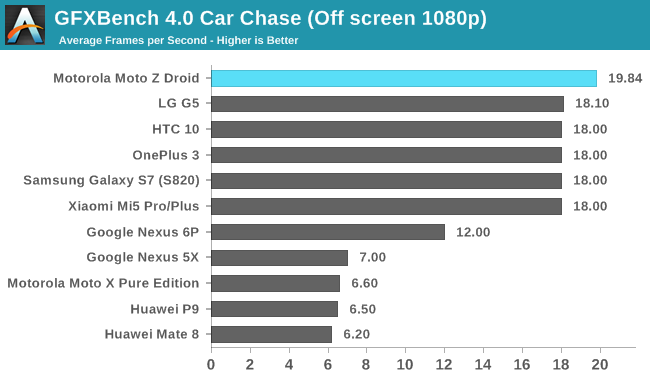
The Adreno 530 GPU in Qualcomm’s Snapdragon 820 performs well in GFXBench Car Chase, a game simulation that uses OpenGL ES 3.1 plus Android Extension Pack (AEP) features, including hardware tessellation. All of the phones with this GPU inside hit 18fps in the offscreen test except the Moto Z Droids, which see a 10% boost from their updated GPU driver. The OnePlus 3 and Xiaomi Mi5 pull ahead in the onscreen test because of their lower-resolution 1080p displays, but the Moto Z Droids still outperform the other QHD resolution phones.
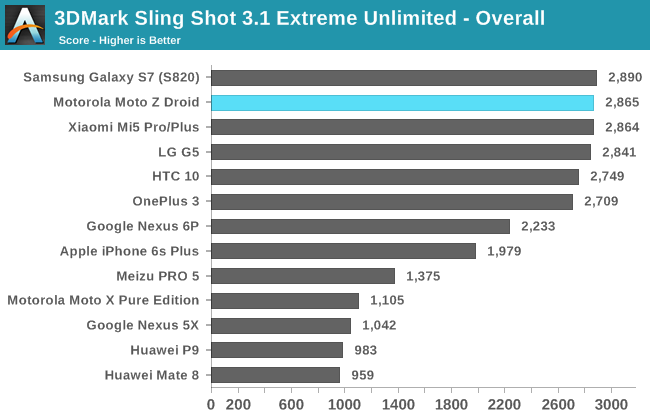

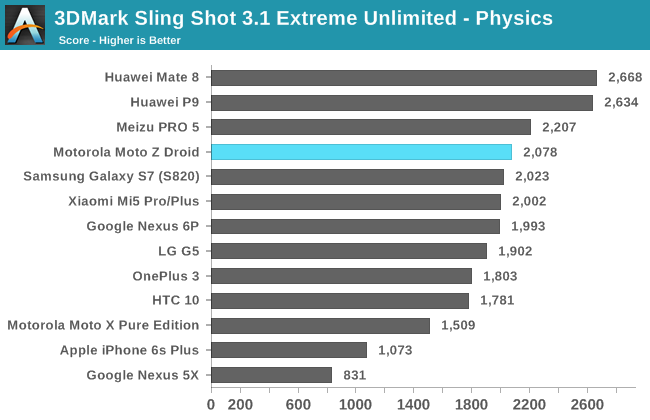
3DMark Sling Shot Extreme is another OpenGL ES 3.1 game simulation that renders offscreen at a higher 1440p resolution than our other tests and does not use hardware tessellation. Once again we see the phones using the Adreno 530 GPU perform well in the Graphics test. Interestingly, the Moto Z Droids see no uplift in performance here from their newer driver.
The Physics test renders offscreen at 720p and primarily tests CPU and memory controller performance. ARM’s A57/A72 CPUs and memory controller handle this particular workload better than Qualcomm’s solutions. The Moto Z Droids are the fastest Snapdragon 820 phones, though.
Both Moto Z Droids deliver excellent performance. Even though they share much of the same internal hardware with other current flagship phones, an updated GPU driver and other software tweaks give them a slight edge in most workloads. Internal storage performance is excellent, leading to quick app loads and installs. Poking around in the UI and scrolling in web pages seems just a little faster when compared to the Galaxy S7 edge, too.










75 Comments
View All Comments
grayson_carr - Thursday, July 28, 2016 - link
I should also say, I would have bought the regular Z and put up with a battery mod if it had the same camera as the Force. Giving the $620 standard Z, the true flagship for everyone who isn't a Verizon customer, a vastly inferior camera was a big, big mistake. I think that decision will have a direct and noticeable negative impact on sales. No one wants a $620 flagship phone with a mediocre camera in 2016, and Motorola has a great camera in the Force at their disposal! It boggles the mind. Using a different camera module in one takes more engineering resources too. Stupid, stupid, stupid.mortimerr - Thursday, July 28, 2016 - link
I would love to know what the total cost for materials is for the Moto Z. The Sony IMX214 is only used in budget devices from Chinese OEMs and devices from 2014.Cliff34 - Thursday, July 28, 2016 - link
It looks more like a marketing decision than an engineering one.kmmatney - Thursday, July 28, 2016 - link
Can you put a tempered glass cover over one of these? That should keep it from scratching.peterfares - Thursday, July 28, 2016 - link
Waiting for someone to make a keyboard mod. I'll upgrade from my PRIV immediately, the SD808 is such a terrible SoC.Manch - Friday, July 29, 2016 - link
YES!!!!! Make a keyboard attachment and Ill throw my money at them. I fucking hate touch screen kb. Took me forever to give up my original Samsung Galaxy LOL.UtilityMax - Thursday, July 28, 2016 - link
Another carrier locked flagship phone priced at +600USD, or priced at 700+ USD for the non-castrated version. Big YAWN. I don't know why I'd buy this when Nexus 5X is now on an everyday sale at about 240-250USD, and Nexus 6P, together with Oneplus 3, is 400USD.fliptwister - Thursday, July 28, 2016 - link
Very good review. I agree with most of it. I picked up the Moto Z Force today at Best Buy and I'm very impressed with the phone. The Force is thinner than I was expecting and the battery time is awesome. I have been on phone now for 4+ hours non stop and have only gone through 20% of the battery. What is really impressing me is how snappy the phone feels. My wife has the LG G5 and my buddy has the S7. I have played with these phones extensively and the Moto Z is faster. Apps open instantly. There is no hesitation in any of the phone's functions. I have not tried camera yet but I'm looking very forward to it. I get what they say in conclusion about price but the deal that Best Buy has now makes this a much better deal. I bought the Moto Z Force for $524 and I got a free JBL Soundboost Speaker (valued at $80).aryonoco - Friday, July 29, 2016 - link
Thank you for your attention to monthly security updates and dedicating a good paragraph or two to the issue.No matter how good your camera is or how well-calibrated your display is, I find it completely unacceptable for an OEM to sell a product with known and published remote root vulnerabilities.
I remember a time, pre Windows XP-SP2 when Microsoft didn't provide monthly security patches, saying similar things about the need for Enterprise testing etc. Then the tsunami of malware happened and MS and the whole PC industry recognised the need for timely security updates. Google and the mobile ecosystem is now at a similar juncture. It took Google years to finally accept the need for timely security updates, but now that they do provide monthly patches, it's up to the OEMs to follow suite.
Android OEMs need to commit to monthly security updates, and need to commit to providing such updates for a set period of time after the phone is released. Selling a phone which holds so much private information with known remote kernel-level vulnerabilities is not ok. Until such time that Android OEMs understand this, my only advice to people who care about security is: buy an iPhone, or buy a Nexus.
BrokenCrayons - Friday, July 29, 2016 - link
Yeah, how about no? Aside from the name "Moto" being utterly grating to the mind to read and even stupider sounding to utter, $600+ for a phone is really exploiting peoples' lack of self control in making decisions about what to purchase..even moreso because they're going to end up paying around $2,400 more to feed it a data connection from a cellular carrier over the course of a couple years. Fine, for a lot of us that's a drop in the bucket compared to our incomes, but I see an awful lot of lower income wage workers forking over a not-insignificant chunk of their annual income to obtain a phone from their TELCO gods.